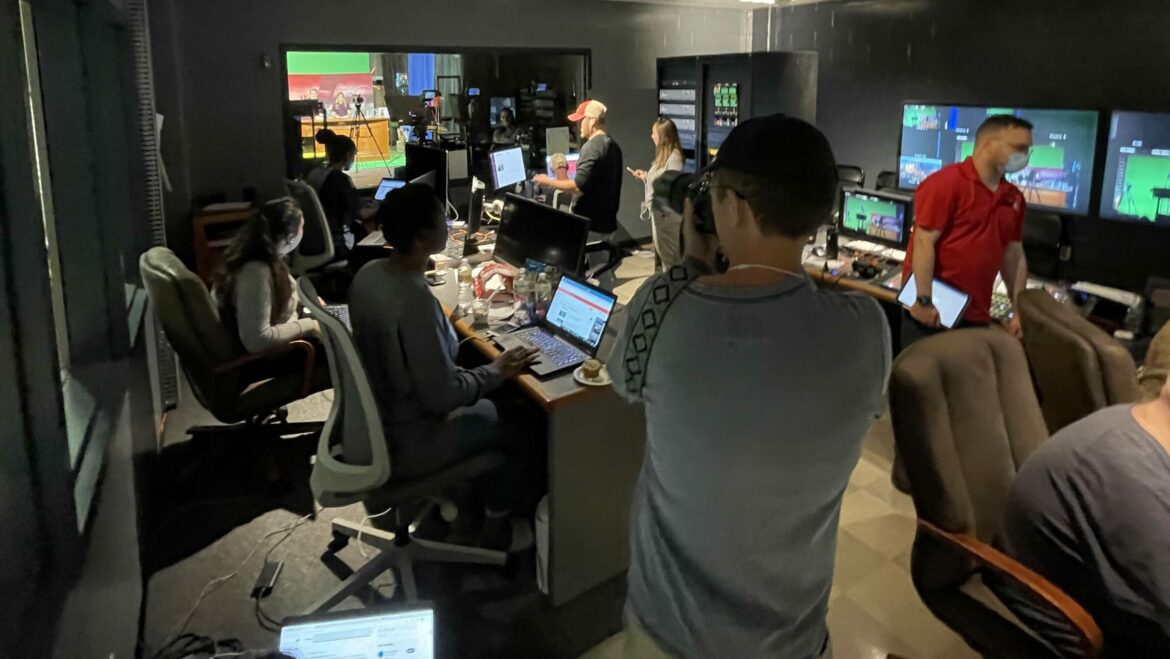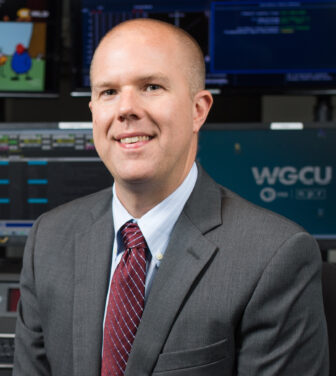How WGCU rode out Hurricane Ian and maintained radio service through the thick of the storm

Kevin Trueblood / WGCU
WFTX's news team produces coverage of Hurricane Ian from WGCU's TV control room.
When Hurricane Ian headed for the coast of southwest Florida in late September, the region’s public broadcaster girded to deliver more than just its own coverage of the storm’s impact.
Based at Florida Gulf Coast University, WGCU is a joint licensee with TV and FM stations in Fort Myers and a second FM transmitter to the south in the Naples area. Many of its staffers, including Kevin Trueblood, associate GM for technology and operations, had fresh memories of how the station had weathered Hurricane Irma in 2017, and had taken steps to prepare for the next monster storm. While WGCU employees and their families took shelter at the station’s building on the FGCU campus five years ago, Irma’s hurricane-force winds shook the front doors but left the facility otherwise unscathed.
For Ian, the scene inside the station was quite different.
The pubcaster’s resilience during the 2017 hurricane caught the attention of the local Fox TV affiliate, WFTX. Its corporate owner, Scripps, was looking to meet a national mandate to establish emergency backup facilities that could keep its stations broadcasting locally during a natural disaster. WFTX’s studios in low-lying coastal Cape Coral had been rendered unusable by Irma. Before that hurricane made landfall, WFTX’s staff decamped to a sister station in Tampa, two hours north.
“They wanted to have something locally that they could basically hit the eject button from their own facility for whatever reason,” Trueblood said.
Scripps’ investment in the emergency plan included sealing a deal with WGCU that included an annual retainer fee and installation of a fiber circuit connecting WGCU’s studios to the company’s disaster recovery hub in Detroit. As Ian barrelled toward Fort Myers four years into the agreement, the agreement paid off for both stations.
Three days before the storm hit, when most forecasts were still predicting landfall to the north in the Tampa area, WFTX’s news staff conducted a Sunday night dress rehearsal at the WGCU studio as a precaution. On Sept. 27, the forecast began to shift. WFTX’s meteorologists realized their station’s studio would be in the line of fire for winds of over 100 miles an hour, Scripps’ criterion for triggering a move.
Keeping close quarters
That night, the WGCU building was full of employees for both stations. About 40 WFTX news staffers took up residence with as many as 25 WGCU news and engineering employees.
“Part of the reason why this agreement worked is that we’re not using our TV studio facilities when we’re in the thick of storm coverage,” Trueblood said. “We’re in the radio half of the building, so we weren’t really on top of each other.”

As the storm raged and coverage continued, WFTX split its staffers into two teams that worked 12-hour shifts. Since nobody could leave, much of the building became a rest area for off-duty Scripps staffers. “We had people in the front lobby playing Uno, just hanging around and playing video games or whatever,” Trueblood recalled. WGCU’s smaller news staff camped out on the radio side of the building. “If they weren’t sleeping, they were working.”
Meanwhile WFTX’s news team anchored and produced coverage from the TV studios, using the fiber circuit to send video feeds to the control room in Detroit that handled switching and graphics. WGCU-FM’s newsroom began producing its own non-stop radio coverage on Wednesday morning as the storm approached landfall.
In addition to reporting by its own staff from the studio and in the field, WGCU depended heavily on the statewide Florida Emergency Radio Emergency Network, based at the University of Florida in Gainesville, which was safely out of the storm’s path.
“Those guys are phenomenal,” Trueblood said. “It is such an excellent resource to have. … A team of meteorologists tells you the conditions, what to expect [and] what the storm is doing.” That coverage allowed WGCU’s team to focus on reporting about “evacuations and shelters and where to get resources and what to do.” There was some overlap in the reporting, “but between the two of us it was just perfect coverage for what we were doing.”
‘Keep track of what’s failing’
While WGCU’s news staff worked with FPREN, Trueblood and his engineering team had to deal with their own challenges of getting their transmitter sites hardened and ready for the storm.
“It was preparing our sites and making sure that we had generator fuel, making sure our sites were cleaned up and secure so that we didn’t have any flying projectiles,” he said.
Even the most careful preparations couldn’t withstand Ian’s triple-digit winds and driving rain, though.
“When you’re in the thick of the hurricane, all you can really do is just ride it out and keep track of what’s failing,” Trueblood said. Using remote monitoring systems, WGCU’s engineers watched security cameras as the storm blew open the front door to the station’s main TV and FM transmitter site. WGCU’s studios never lost power or connectivity during the storm, but the transmitter site didn’t fare as well. It lost generator power and both fiber and microwave connections back to the studio.
The damage knocked WGCU-TV completely off the air. WGCU-FM was able to keep serving listeners in the immediate Fort Myers area thanks to another backup: An auxiliary FM transmitter facility on a tower adjacent to the FGCU campus that Trueblood had built after Irma. For about 36 hours at the height of the storm, WGCU-FM remained on the air from that backup tower. It was one of only a handful of regional broadcasters that was able to maintain service through the storm.
The aftermath of Hurricane Ian
Another lesson learned from Irma, Trueblood said, was the need to prepare for a longer recovery once the storm itself has passed. While WGCU’s studio had power and connectivity, the campus and all of surrounding Lee County lost water service when treatment facilities failed after the storm.
“That presented some challenges, because now you only have semi-functional restroom facilities,” Trueblood recalled. “We had plenty of bottled water, but the campus chiller plant relies on water to function, so we started losing air conditioning. If you were watching Fox through the day on Friday, it was starting to get a lot warmer in the building. We put a big fan on next to the anchor, and you could see the wind blowing.”
The bathroom facilities at WGCU were only partially functional, so staffers had to trek across campus to use portable toilets that had been set up in a shelter area at FGCU’s arena.
The situation began to improve by the afternoon of Friday, Sept. 30. Water service was restored, so the air conditioning system and restrooms were back in service. After 36 hours off the air, WGCU-TV resumed broadcasting and WGCU-FM returned to full power.
“We all kind of looked at it as there’s no competition here — we’re all serving the public interest. That’s what matters right now. ”
Kevin Trueblood, WGCU
By Friday night, WFTX had confirmed its own studio building was secure and had taken only minor water damage. Its news staff moved back to Cape Coral in stages, vacating WGCU’s studios until the next time the emergency agreement is needed. But then WINK-TV, Fort Myers’ oldest and most-watched commercial station, considered taking up residence after its studio building in downtown Fort Myers flooded.
Ian knocked the CBS affiliate off the air at the height of the storm on Sept. 28. WINK resumed broadcasting Oct. 1 from a very makeshift studio at its transmitter tower. The staff began moving back into its downtown studios, working around Serv-Pro cleanup crews who cut away soaked drywall and tried to mitigate water damage to racks of electronic equipment.
WGCU offered its studios to WINK as a temporary facility while its studios were rebuilt. After several days of discussion and a tour, Trueblood said, WINK decided it could keep operating from downtown while cleaning up and reconstructing.
“We all kind of looked at it as there’s no competition here — we’re all serving the public interest,” Trueblood said. “That’s what matters right now.”
“In terms of engineering and support, it’s important to establish those relationships and be resourceful, because other broadcasters are more than willing to help in those kinds of times,” he said.
Help from pubmedia colleagues
One lesson WGCU learned from Irma was the importance of looking after employees’ personal needs. During that storm, many WGCU employees brought family members to stay at the station; this time, many, including Trueblood, sent their families out of town for the duration. (Trueblood did make one important exception. His dog, Smithers, took up residence at WGCU, staying out of the way in a closet that Trueblood had converted to a small den for his four-legged assistant.)
To give staffers time to attend to their own damaged or destroyed homes and other family needs, WGCU had help from other public stations around Florida. In the weeks following Ian, reporters traveled from WLRN in Miami, WUSF in Tampa, WUFT in Gainesville and WFSU in Tallahassee to provide much-needed relief.
“Our reporters were able to go home and take care of what they needed, while we were still getting information out to the public,” Trueblood said.
As a university licensee, WGCU was also able to take advantage of a leave pool FGCU established to make sure staffers who needed to take time off could do so without losing pay.
While the region’s recovery is going faster than he’d expected, WGCU is still proceeding “one day at a time,” Trueblood said. That includes fundraising. A pledge drive in October was canceled after the storm. Trueblood expects the station will soon begin reminding listeners of how valuable its service was during Ian.
As listeners think about how long they were without phone service or power during the storm, one pledge premium Trueblood expects to be especially popular is a crank-powered radio, which WGCU offered in its spring drive. “It’s an Eton brand, and they can be solar charged, they can be cranked or they can be charged by a USB. I suspect we’re going to do a lot more of those in the future.”
“I really hope that resonates in our community with how … much of a lifeline we are,” he said. “We continue to seize these opportunities to be there for our community. I just hope in the minds of consumers, that they don’t forget that.”
Correction: An earlier version of this story omitted mention of WLRN in Miami as one of the Florida stations that sent its journalists to report for WGCU after Hurricane Ian.






